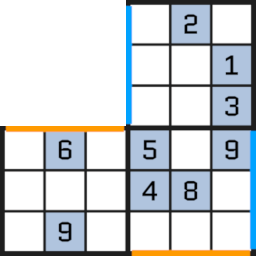Number Space
This site requires a wider window, and also uses the keyboard and mouse.
Instructions
A single cell is filled in with orange when the game is paused. Moving the mouse over this highlighted cell will resume navigation. Moving the mouse away from the Sudoku board will pause the game. To fill in the puzzle, navigate to a white cell and press a number key to insert a digit. At this point the row, column, and 3x3 block that contain the selected cell will be visible. In a solved puzzle each of these three areas will contain all of the digits 1-9. Press "backspace", "delete", or "0" to clear a cell. Press "escape" to return to the starting position. Click on the thumbnail images above to switch between puzzles. Reloading the page will erase your progress.
Explanation
When using the mouse to navigate the board, it may look like the numbers are changing. They are not changing, but coming into and out of view. Retracing the mouse's movement will return to the previous views. All of the puzzles here are displayed in the same way. The visible part of the game board is every location that can be reached via a straight line path from the current mouse position.
Puzzle One
The first of the puzzles listed above contains exactly 27 cells. It can be alternatively drawn like this:

There are only three columns, and they pass through the orange portal. The three rows pass through the blue portal.
Puzzle Two
The idea with all of these puzzles is to play normal Sudoku on a differently shaped board. Consider this network with nine nodes:
The nodes represent the nine 3x3 blocks of a regular Sudoku board. The network connections give information about how the blocks are positioned next to each other. Here is an analogous network for the second puzzle, which has eighteen blocks:
It is almost like two regular boards that have been linked together.
Puzzle Three
Here we switch out the nine digits for another set of symbols.

Look at the top left block while in the starting position of this puzzle. The top right block is the same as the top left, but rotated 90 degrees clockwise. The middle cell of the top left block appears twice in its row. This only works because the 3 becomes a different symbol when rotated. Colors stay the same no matter how you look at them.
Puzzle Four
A symbol like the letter F can be rotated and reflected into eight separate Sudoku symbols.

This puzzle and the first one repeat diagonally. Even though both puzzles contain only three blocks, you could walk in a straight line forever. You can think of the first puzzle as existing on the surface of a cylinder. Each block only appears once on this surface. Then by walking diagonally you loop around the cylinder and return to where you've been before. Can you imagine what sort of surface puzzle four lives on?